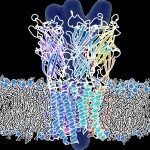Link to Pubmed [PMID] – 28170254
Link to HAL – Click here
Link to DOI – 10.1021/acs.jctc.6b01136
J Chem Theory Comput 2017 Mar;13(3):1424-1438
Understanding the dynamics of biomolecules is the key to understanding their biological activities. Computational methods ranging from all-atom molecular dynamics simulations to coarse-grained normal-mode analyses based on simplified elastic networks provide a general framework to studying these dynamics. Despite recent successes in studying very large systems with up to a 100,000,000 atoms, those methods are currently limited to studying small- to medium-sized molecular systems due to computational limitations. One solution to circumvent these limitations is to reduce the size of the system under study. In this paper, we argue that coarse-graining, the standard approach to such size reduction, must define a hierarchy of models of decreasing sizes that are consistent with each other, i.e., that each model contains the information of the dynamics of its predecessor. We propose a new method, Decimate, for generating such a hierarchy within the context of elastic networks for normal-mode analysis. This method is based on the concept of the renormalization group developed in statistical physics. We highlight the details of its implementation, with a special focus on its scalability to large systems of up to millions of atoms. We illustrate its application on two large systems, the capsid of a virus and the ribosome translation complex. We show that highly decimated representations of those systems, containing down to 1% of their original number of atoms, still capture qualitatively and quantitatively their dynamics. Decimate is available as an OpenSource resource.


